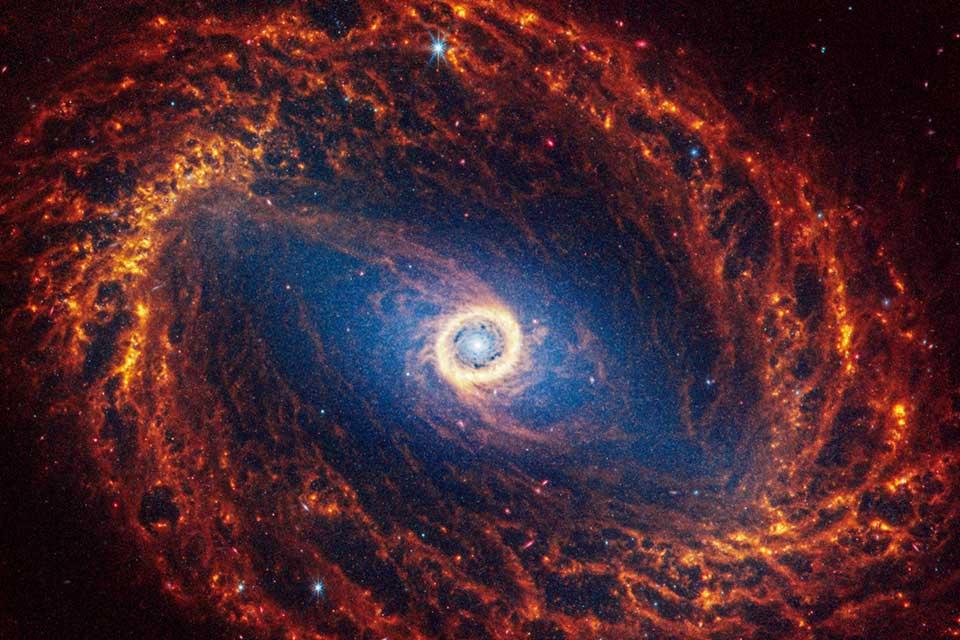11. Planetary Moons and Rings#
11.1. Using Moons to Compute the Mass of a Planet#
Recall from Chapter 4, we used the orbital motion of Europa to calculate the mass of Jupiter. We used the following equation:
where \(a\) is the semimajor axis, \(P\) is the orbital period, and \(M\) is the mass of the central body. If we choose to measure \(a\) in AU, \(P\) in years, and \(M\) in \(M_\odot\), then \(G = 4\pi^2\). Then the equation becomes simpler,
This equation was used to determine the mass of Pluto with greater accuracy. Prior to the discovery of Charon, Pluto’s mass was estimated based on its brightness. But with a newly discovered moon, the mass could be determined more precisely using the orbital motion of Charon.
Charon has an orbital (sidereal) period of 6.387 days and a semimajor axis of about \(16.5\) Pluto radii. Pluto’s radius is about 0.185 times the radius of Earth. We need to first do some unit conversions before getting down to business:
Since we have the semimajor axis in AU and orbital period in years, then we can apply our version of Kepler’s 3rd Law. The mass of Pluto is given by
Note
Recall from Chapter 1 that this calculation can be made easier (i.e., fewer parentheses) to enter in the calculator by using the EE button.
Pluto’s mass is very small compared to the Sun. However, we can convert the value to instead compare to the Earth’s mass or even the Moon’s mass (\(M_{\rm Moon}\)), by
We find that Pluto’s mass is about \(19.5\%\) of our Moon’s mass. This isn’t completely correct, rather the combined mass of Pluto and Charon (\(M_{\rm Pl} + M_{\rm Ch}\)) is \(19.5\%\) of our Moon’s mass. To get Pluto’s mass, we need to perform a separate experiment to identify Charon’s mass relative to Pluto. Since Charon eclipses Pluto periodically, we can determine the mass ratio \(M_{\rm Ch}/M_{\rm Pl} = 0.122\) from a combination of spectra and photometry. Transforming what we know in terms of this ratio, we get
which is close to the true value for Pluto’s mass of \(17.7\%\) of the Moon’s mass.
Pluto has 4 other moons (Nix, Styx, Kerberos, and Hydra), but these orbit the Pluto-Charon barycenter. Their motions can be used to more precisely determine the combined mass of Pluto and Charon.
days2year = 365.25 #days in a year
RE2AU = 4.264e-5 #AU in an Earth Radius
M_E = 3.003e-6 #Earth mass in solar masses
M_Moon = 0.0123 #Moon mass in Earth masses
P_Charon = 6.387 #orbital period in days
a_Charon = 16.5 #semimajor axis in R_Pl
#Note the *= operator allows for multiplication and storage in a single step
#Example: x *= 5 --> x = x*5
a_Charon *= 0.185*RE2AU #Pluto' radius is ~0.185 R_E
P_Charon /= days2year
print("Charon's semimajor axis in AU is: %1.4g" % a_Charon)
print(("Charon's orbital period in yr is: %1.3g" % P_Charon))
print("------")
M_Pl = a_Charon**3/P_Charon**2
print("Pluto's mass (in Msun) is: %1.3g" % M_Pl)
print("Pluto's mass (in M_E) is: %1.4g" % (M_Pl/M_E))
print("Pluto's mass relative to Earth's moon is: %1.3g" % (M_Pl/(M_Moon*M_E)))
print("------")
#Need to correct using the Charon-Pluto mass ratio
mass_ratio = 0.122 #Mass ratio of Charon to Pluto
M_Pl = M_Pl/(M_Moon*M_E)/(1+mass_ratio)
print("Pluto's mass relative to Earth's moon is: %1.3g " % M_Pl)
Charon's semimajor axis in AU is: 0.0001302
Charon's orbital period in yr is: 0.0175
------
Pluto's mass (in Msun) is: 7.21e-09
Pluto's mass (in M_E) is: 0.002401
Pluto's mass relative to Earth's moon is: 0.195
------
Pluto's mass relative to Earth's moon is: 0.174
11.2. Tidal Forces on the Moons#
Recall from 4.4 Tidal Forces, we compared the tidal forces on the Earth due to the Sun and the Moon. A similar logic/equation can be applied to compare the tidal forces from Jupiter acting on Io or Europa. Starting from
\(F_{\rm tidal}({\rm moon}) = 2\left(\frac{GM_{\rm Jup}m}{d^2_{\rm Jupiter-moon}}\right)\left(\frac{R_{\rm moon}}{d_{\rm Jupiter-moon}}\right), \)
where we substituted \({\rm Moon} \rightarrow {\rm moon}\) to indicate that we are calculating the tidal force for a mass \(m\) on the respective moon (Io or Europa). The central body in this case is Jupiter instead of the Earth. Now we can compare the relative tidal strengths on each of the two moons:
Therefore, we need to know the radius and distance ratio of the the two moons to determine how much stronger/weaker is the tidal force from Jupiter on each. We can find the mean radius of Io (\(R_{\rm Io} = 1821.49\ {\rm km}\)) and Europa (\(R_{\rm Europa} = 1560.80\ {\rm km}\)) tabulated by NASA JPL. The semimajor axes for Io and Europa are tabulated in Appendix 4 of the textbook, which are \(422,000\ {\rm km}\) and \(671,000\ {\rm km}\), respectively.
We find the relative tidal force between Io and Europa by,
This, the tidal forces on Io are \(4.69\times\) stronger than those on Europa.
R_Io = 1821.49 #radius of Io in km
R_Eur = 1560.8 #radius of Europa in km
d_Io = 4.22e5 #semimajor axis of Io in km
d_Eur = 6.71e5 #semimjaor axis of Europa in km
F_tide = (R_Io/R_Eur)*(d_Eur/d_Io)**3
print("The relative tidal force between Io and Europa is: %1.3g" % F_tide)
The relative tidal force between Io and Europa is: 4.69
11.3. Feeding the Rings#
Rings are not forever, where they disspate over time through a process called viscous spreading. The rings act like a slowly moving fluid where the expand outward and inward due to collisions between ring particles. Recall from Chapter 7 this was part of the reason that protoplanetary disks form at all. Think of a pizza dough that you keep spinning, where it stretches out and becomes thinner over time.
We’ve seen that some ring material can be kept in place through shepherding moons. Another way to replenish the rings is through material that continually escapes from a nearby moon. Io’s volcanic eruptions feeds material into a plasma torus that surrounds Jupiter and emits radio waves.
Saturn’s moon Enceladus has cryovolcanism, which is seen near the tiger stripes. Material (i.e., water + organic molecules) escape Enceladus due to its low surface gravity and escape velocity. The escape velocity of a body relative to Earth’s value (\(v_{\rm esc}^{\rm Earth} = 11.186\ {\rm km/s}\)) is given by:
By writing the equation this way, we don’t need to know the value for \(G\). Moreover, we only need to know the mass and radius of Enceladus relative to the Earth. These values are tabulated on Wikipedia:Enceladus, which are updated periodically. Enceladus is \(1.812\times 10^{-5}\) of Earth’s mass and \(0.0396 R_\oplus\). With these values, we find that the relative escape velocity is
This means that the escape velocity of Enceladus is:
The speed of particles from Enceladus’ icy plumes is nearly \(2200\ {\rm km/h}\), which shows that they can easily escape from Enceladus and supply the E-ring with fresh material over time.
import numpy as np
mass_ratio = 1.812e-5 #Enceladus' mass in Earth masses
radius_ratio = 0.0396 #Enceladus' radius in Earth radii
v_esc_Earth = 11.186 #Earth's escape velocity in km/s
sec2hr = 3600. #seconds in an hour
v_ratio = np.sqrt(mass_ratio/radius_ratio)
print("The escape velocity ratio between Enceladus and Earth is: %1.3g" % v_ratio)
print("The escape velocity of Enceladus is: %1.3g km/s" % (v_ratio*v_esc_Earth))
print("The escape velocity of Enceladus is: %1.3g km/h" % (v_ratio*v_esc_Earth*sec2hr))
The escape velocity ratio between Enceladus and Earth is: 0.0214
The escape velocity of Enceladus is: 0.239 km/s
The escape velocity of Enceladus is: 861 km/h


